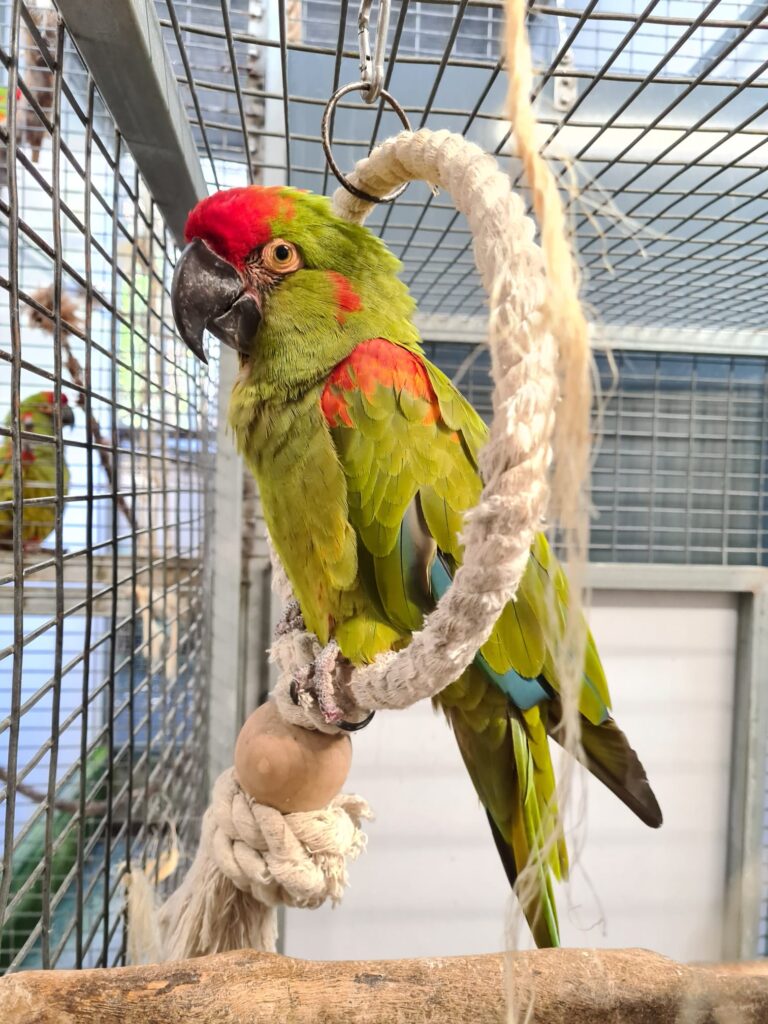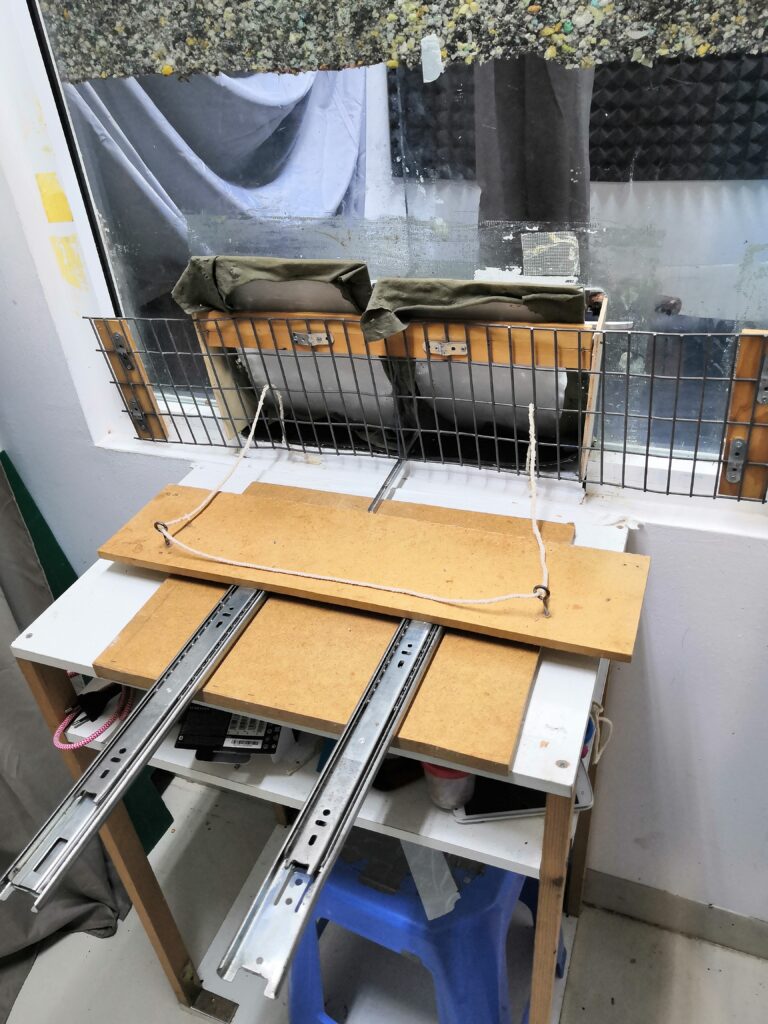Subjects and housing condition
I tested seven red-fronted macaws (A. rubrogenys) (Figure 1), four males (Khal, Tormund, Tyrion and Jaime) and three females (Brienne, Cersei and Khaleesi). They were hatched between 2016 and 2020. All parrots were housed in aviaries at the Max-Planck Comparative Cognition Research Station in the Loro Parque in Puerto de la Cruz, Tenerife. They lived together in a group of eight individuals in a shared aviary made of mesh of 1.8 m × 3.4 m × 3 m (width × length × height). The aviary had one side open to the exterior, so the parrots had access to natural light and the outdoor temperature, although there were additional lights to ensure they were sufficiently exposed to UV light (Arcadia 54W Freshwater Pro and Arcadia 54W D3 Reptile lamp). The aviary was connected to a transport cage, which was used to transport dyads of birds to the testing chamber.

Experimental room and setup
The training and testing chambers were indoor rooms equipped with the same UV lights as in the aviary. The testing area consisted of 2 chambers, each 2.5 m × 1.5 m × 1.5 m (height × width × length), separated by a window (1 m × 1 m) with an opening that connected both chambers through wire mesh. One testing chamber was set for the birds and the other one to place the apparatus and for the experimenter. In the birds’ chamber, I used a carpet to cover the table to avoid sound cues from the footsteps. The walls were covered with acoustic isolation foam to avoid echoes from the vocalizations. The parrots’ chamber was subdivided in two different compartments through a plexiglass wall separating the two subjects of each dyad side by side. Depending on the testing condition, I left the plexiglass uncovered, and the dyads had visual contact, or I attached visual barriers to avoid visual feedback. The room was divided so that each parrot could not steal the rope from one another or disturb each other. Each testing chamber was equipped with surveillance cameras in the four corners of the room at different heights and orientations. One additional video camera was installed in the birds’ room to record their vocalizations together with the images, and a couple of audio recorders.
The setup consisted of a platform of 1 cm x 15 cm x 60 cm (height x width x length) that was fixed on two ball-bearing drawer slides that allowed for a smooth sliding motion and made the platform stable. The setup was fixed to a small table in the experimenter chamber with strong double-sided tape to ensure its stability in all conditions. A polyester rope with a length of 135 cm passed through two eyelets in the corners of the far end of the platform from the birds’ chamber. The string ends were fed through the mesh holes, so they were far enough to be available for the birds to grab with their beak. A unilateral tug on either string end should not move the platform but only affect the other string end, moving it out of reach of its partner. The apparatus could be separated from the birds´ chamber with two opaque doors, which could easily be lifted by the experimenter from his side of the testing chamber. These opaque doors also ensured that the birds did not see the baiting procedure or had access to the string and apparatus.


Procedure
Prior to testing, the affiliative and agonistic relationships among the birds were assessed. Behavioural observations of the whole group were carried out at four different times of the day for a 14-day period (morning: 9:20-10:00, midday: 11:30-12:00, afternoon: 14:00-14:30, evening: 17:30-18:00). Every observation lasted for 16 min, during which scan samples for proximity behaviours were recorded every two minutes (nine scans in total per observation), whilst agonistic and affiliative interactions were recorded using continuous all-occurrence-sampling during the observational session.
I chose the dyads of birds for testing based on the behavioural observations (Table 3 of the appendix). For this purpose, the composite sociality index (CSI) (Silk et al., 2013) was calculated for all dyads based on their proximity and affiliative interactions. The six dyads were chosen adjusting to the CSI as much as possible, while keeping the sex ratio balanced and avoiding birds participating more than once for the affiliative or agonistic pairing.
Final dyads:
Affiliative dyads: Agonistic dyads:
Jaime/Khaleesi Brienne/Tyrion
Cersei/Brienne Tormund/Khal
Khal/Tyrion Cercei/Khaleesi
Habituation
For the habituation phase, I brought the birds to the experimental room with their affiliative partners to get them used to the room and the setup. When the birds moved freely and ate, I introduced the ropes with food rewards attached, so the ropes would be familiar to the parrots. Once the birds were familiar with the ropes and presented signs of relaxation, the last step was to introduce them to the sliding platform with food on it, and slowly show them the platform sliding to avoid fear reactions during testing. Once all birds were comfortable and relaxed with all the equipment, the next step was to move on to the first training condition. The habituation period took between four and six weeks depending on the parrots.
Cooperative training phase
In the cooperative training phase, the birds had visual contact with each other. During training, both birds had access to the string when I placed it into their respective cages. Each bird was tested with each partner until they reached the criterion of solving five consecutive trials within a session. The training phase consisted of three sessions of 20 trials with a prior and posterior training of pulling the string, 10 attempts per bird. The training of pulling consisted of calling actively the birds and play with them to pull the rope whilst I was offering resistance. This phase ended when the birds reached the criterion of collaborating pulling the string five times in a row. The cooperative training phase was done with all the dyads for six days, except for one that needed to repeat it up to nine days.
Individual training phase
If the parrots did not move freely around the set up and pulled the ropes on their own after three sessions, I started training the birds individually to pull the rope strong enough to move the platform closer and reach their reward. This active training was performed in three sessions of 20 trials per bird before repeating the cooperative training phase. The number of sessions needed was three, six and nine respectively.
Cooperative condition
In the first experimental condition, the birds had visual contact with each other. In this condition, both birds had access to the string after I placed the string in their respective compartments and raised the opaque door. Each bird was tested with each partner in two sessions of 10 trials per day, giving a total number of 12 sessions for all dyads.
Delayed condition
In the second experimental condition, the birds also had visual contact but the opening of the second opaque door was delayed for 5-15 s in intervals of one second randomly in order to make the exact arrival of the partner unpredictable. So, the bird with first access to its end of string (Bird 1) had to wait for the arrival of its partner (Bird 2) to be able of moving the platform and getting the food reward by pulling the platform together. Therefore, the birds had different roles once the first trap door was opened: either waiting for the arrival of the partner after a variable amount of time in the test area (Bird 1) or waiting for a variable amount of time in the waiting area (Bird 2). The birds were tested in a maximum of 20 sessions (2 per day) of 10 trials in each role, switching roles after every session. They had to reach a criterion of having 16 successful trials within 20. Furthermore, as the birds were starting to show signs of demotivation and frustration, three motivational trials were conducted at the beginning, middle and the end of each session to keep them motivated. The motivational trials consisted of repeating the cooperative condition, so, as the parrots were already used to it, they used to get the rewards.
Blind condition
The third condition was designed like the ‘Cooperative condition’, but an opaque barrier was attached to the plexiglass between the two compartments, keeping the dyad visually isolated but acoustically in contact. Again, each dyad was tested in 2 sessions of 10 trials, giving a total number of 12 sessions for all dyads.
Blind delayed condition
The fourth cooperative condition was designed like ‘Delayed condition’ but with an opaque barrier attached to the plexiglass between the two compartments to keep the birds visually isolated. For this condition, the dyads were tested in a total of four sessions (two per day) of 10 trials, switching roles after every session in randomised sides. A total of 24 sessions were carried out between all six dyads.
Data analysis
To understand if the red-fronted macaw (Ara rubrogenys) was aware of the need of a partner to solve the loose string test and if social bonds affect its performance I tested: 1) if the success rate for the cooperative, delayed and blind delayed conditions was above chance level (I excluded the delayed condition from the binomial test because the birds had to reach the criterion, which was considered as succeeding in the task); 2) if there were differences between ‘Affiliative’ and ‘Agonistic’ groups for each condition; 3) if the success rate varied across different conditions; 4) if any of the groups (affiliative or agonistic) understand the need of cooperating in a shorter period; 5) and if there were individual differences that increase the success rate depending on which bird had access to the string first.
I used the binomial test to assess whether birds, considering their affiliation, were able to cooperate to succeed in the task. I also used the Chi-square test to do pairwise comparisons and check if there were significant differences depending on their affiliation for each condition; if their performance differed across cooperative, blind and blind delayed conditions; to compare the learning time depending on their affiliation; and to find out if there are individual birds which performance increase the success in the blind delayed condition. To represent graphically the results obtained I worked with Rstudio and the “ggplot2” package.